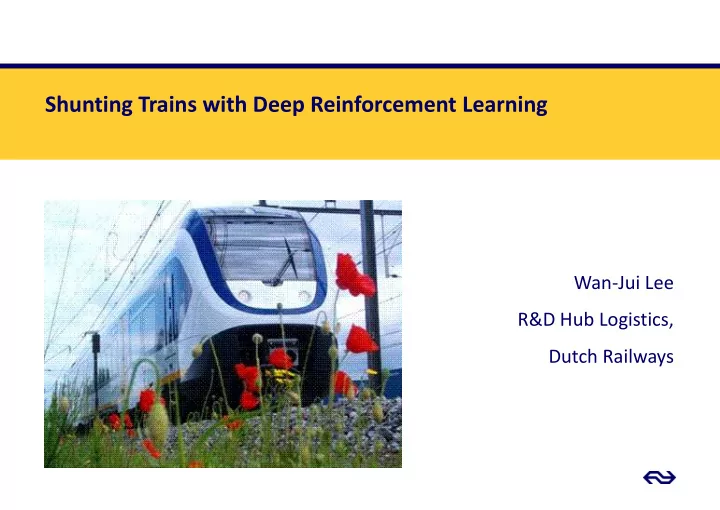

Shunting Trains with Deep Reinforcement Learning Wan-Jui Lee R&D Hub Logistics, Dutch Railways
Meet the fleet of NS
Train Unit Shunting Problem Service Location with carousel layout (Den Haag Kleine Binckhorst)
Shunt Plan Simulator Capacity Analyzer Storage and Retrieval Instance Constraint Initial Solution Local Search Generator Checker
Example of a Shunting Instance
Processes at Service Sites Problems to solve • Shunting • Routing • Parking • Matching • Service • Combine • Split ➢ For some yards it takes a human planner up to one day to create a plan for the upcoming night. ➢ The planning task is getting more complex due to increase of trains
What a Shunting Schedule Looks Like
Can machines learn to plan? Reinforcement Learning learns to play a game by gaining experience, just like a human player: ➢ Try various actions in different situations (explore) ➢ Learn/store information about the game that can bem generalized to potentially unseen scenarios ➢ Learn the most valuable actions by using the reward signal (exploit)
Deep Q-Network (DQN) by Google Deepmind Reinforcement Learning + Deep Neural Networks
Q-Learning - A popular Reinforcement Learning algorithm - An extension to traditional dynamic programming - It learns the value for each state-action pair: Q ( s; a ). Q-learning does not scale: we need to store (and learn) each state- action pair explicitly in the Q-Table.
Deep Reinforcement Learning Deep Q-Network (DQN) of Mnih (2015) represents Q-Table using a Convolutional Neural Network. Q1 Q2 State CNN … Qn • Combine reinforcement learning with Deep Neural Networks • No need to learn all state-action pairs explicitly
DRL for TUSP including Service Tasks
Scope of the Problem to be Solved ◼ Single unit trains both in arrival and departure ◼ Cleaning service ◼ Cleaning starts as soon as train put on cleaning track ◼ No simultaneous movement ◼ Agent can move trains as much as time budget allows ◼ Full information on schedule of trains ◼ Trains arrival and task time deterministic ◼ Trains must leave exactly on time
State Space Design (Input to NN) ◼ Position (1-6) of train units on the track: Boolean ◼ Required internal cleaning time of train units: Float (x/60) ◼ Is a train unit under internal cleaning : Boolean ◼ Length of train units: Float (x/500) ◼ Time to arrival of train units : Float (x/720) ◼ Is it the arrival time of a train unit: Boolean ◼ Next 3 departure time of the same material type: Float (x/720) ◼ Is it the departure time of the same material type: Boolean
Action Design (Output dimensions of NN) ◼ 52 track to track movements • 8 parking to gate • 8 gate to parking • (4 parking + 1 relocation) to 2 cleaning Number of actions • 2 cleaning to (4 parking+1 relocation) Q1 • 8 parking to 1 relocation State Q2 • 16*12 CNN 1 relocation to 8 parking … *23 Qn ◼ 1 wait
Trigger Design (Generate Learning Events to NN) ◼ Arrival trigger: train and time ◼ Departure trigger: material and time ◼ End of Activity trigger: train and time ◼ Time trigger: every one hour
Reward Design (Generate Feedback to NN) ◼ Negative rewards: • Relocation: -0.3 • Move to cleaning track while no cleaning required: -0.5 ◼ Positive rewards: • Right departure: +2.5 • Arrival on time: +0.2 • Wait for service to end:+duration/60 • End service: +duration/60 • Find a solution: +5 ◼ Violations: cost a life • Lost 3 continuous lives or no available actions: end the episode
Violations ◼ Choose start track that is empty ◼ Choosing to wait in time for arrival or departure ◼ Parking a train on track relocation track or gate track ◼ Choosing wrong time for departure ◼ Choosing wrong type for departure ◼ Choosing not clean train for departure ◼ Moving train while in service ◼ Track length violation ◼ Missing a departure or arrival while doing other movements
From Q network to Value network TUSP agent has a deterministic policy ▪ It follows Post-decision state variable
Value Iteration with Post-decision State (VIPS) ◼ Reduce the output dimension from 53 to 1 ◼ Instead of estimating Q values of 53 actions (52 movement + 1 wait) at one time, estimate only the V value of the given state. New Old Q1 State State Q2 1610 DNN V 16*12 CNN … *1 *23 Qn
Experiment ◼ Instance Generation: • 5,000 problem instances are generated for 4, 5, 6 and 7 trains each • From these 20,000 problem instances, 1,000 are randomly withdraw as the test instance while the rest are used for training the DRL agents. • The shunting yard studied in this work is ’de Kleine Binckhorst ’ ◼ Neural network architecture • 2 dense hidden layer of 256 and 128 nodes, separately, with ReLu activation function • Output of DQN: 53 dimensional vector; output of VIPS: 1 dimensional vector
Performance: Convergence Q values of VIPS learned on all actions Q values of DQN learned on all actions
Performance: Problem Solving Capability Average percentage of solved instances and standard deviations of different models on solving 5 sets of 200 test instances.
Visualization of a TUSP reinforcement agent
Q&A Further interets/questions: wan-jui.lee@ns.nl
Recommend
More recommend